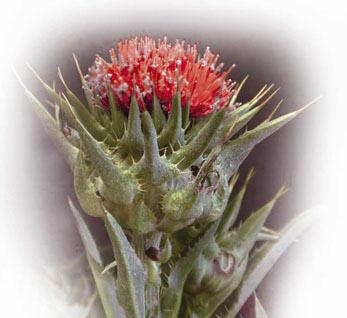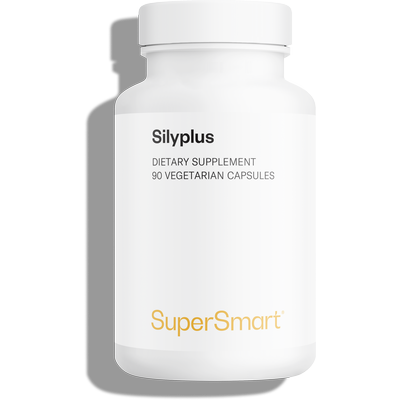29-12-2014
Silymarin - powerful liver-protective properties
 Silymarin is extracted from the seeds of milk thistle, a biannual plant that grows wild in Southern Europe. Silymarin actually comprises three flavonoids - silychristin, silydianin and silybin, the latter being by far the most active. Silymarin is used to treat a number of liver disorders including cirrhosis, alcoholic steatosis or fatty liver, liver poisoning and viral hepatitis. It protects hepatocytes against damage from radiation, iron overload, toxins, viral hepatitis and ischaemia. It may also have benefits for insulin resistance as well as anticancer effects.
Silymarin is extracted from the seeds of milk thistle, a biannual plant that grows wild in Southern Europe. Silymarin actually comprises three flavonoids - silychristin, silydianin and silybin, the latter being by far the most active. Silymarin is used to treat a number of liver disorders including cirrhosis, alcoholic steatosis or fatty liver, liver poisoning and viral hepatitis. It protects hepatocytes against damage from radiation, iron overload, toxins, viral hepatitis and ischaemia. It may also have benefits for insulin resistance as well as anticancer effects.
Milk thistle extract has featured in traditional medicine for more than 2000 years, especially for treating jaundice.
Nowadays it is used in Europe as complementary protection for patients being treated with drugs known to cause liver problems.
While silymarin's hepatoprotective properties are well-documented, its mechanisms of action need further explanation.
It acts directly on hepatocytes, obstructing the absorption of toxins, encouraging their elimination as well as the regeneration of liver tissue. As with other flavonoids, silymarin also has powerful anti-free radical properties, thus preventing certain toxins from causing liver damage.
Powerful antioxidant properties
Silybin is effective at neutralising various free radicals including hydroxyl and peroxyl radicals as well as hypochlorite ion. Although the latter provides important anti-bacterial protection, it can also be extremely dangerous and must be quickly 'disarmed'.In the presence of iron, it creates the hydroxyl radical which can directly attack DNA (Biochem Pharmacol. 1994 ; 48 : 753-9).
Silybin's antioxidant effects have been observed in rats with acute poisoning caused by ethanol or paracetamol which induce peroxidation and cause marked depletion of glutathione in the liver.
Treatment with silymarin or silybin was found to protect the animals from the oxidative stress produced in the liver by ethanol and paracetamol (Biochem Pharmacol 1985 ; 34 :12).
Silybin protects red blood cells and stabilises cell membranes by inhibiting lipid peroxidation. Silymarin and silybin also seem to exert antioxidant effects not only by neutralising free radicals but also by affecting the enzyme systems associated with glutathione. They increase the activity both of superoxide dismutase enzymes and glutathione peroxidase in red blood cells (Acta Physiol Hung, 1992; 80:375-80). Silymarin normalises suppressed SOD activity and compromised immune-reactivity in the lymphocytes of patients suffering from alcoholic cirrhosis of the liver.
Another interesting characteristic of silybin and silymarin is their ability to influence the regulation of glutathione content in various organs. It has been shown that silymarin can increase levels of glutathione by 35% in rat livers. This increase occurs selectively in the liver, intestine and stomach (Planta Med, 1989 ;55 :420-2).
Silybin also protects tissues from iron-induced damage. Iron overload is dangerous because it catalyses various free radicals resulting in peroxidation of lipid membranes. The liver is the primary site for iron’s damaging effects. Silybin’s antioxidant action helps protect against liver toxicity, and scientific data also suggests it acts as an iron chelator, binding to free iron and thus facilitating its elimination via bile (Gastroenterology, 1995 ;109 :1941-9).
Anti-inflammatory properties
As with all flavonoids, silybin is able to inhibit production of nitric oxide which in excess is very destructive. It triggers chronic inflammation and stimulates even greater generation of free radicals.Silybin inhibits the formation of pro-inflammatory prostaglandins (PGE-2) although scientific data suggests this mechanism only works at strong concentrations. However, even at low concentrations, it reduces production of dangerous inflammatory elements called leukotrienes, (Life Sci. 1996; 58: 1951-1600).
Silybin’s powerful ability to reduce leukotriene levels is of particular clinical interest in relation to the treatment of various inflammatory disorders and specifically, to the prevention of gallstones and liver and kidney damage.
Stimulates regeneration of the liver
Silymarin’s ability to stimulate the regeneration of liver tissue could be explained by the fact that it promotes protein synthesis in damaged livers. In vivo and in vitro experiments on rat livers in which part of the liver was removedshow that silybin produces a significant increase in the production of ribosomes, DNA, and proteins. Surprisingly, silybin only affects protein synthesis when the liver has suffered damage (Arzneimittelforschung, 1973; 23: 161-7).
Toxin- or drug-induced hepatitis
In cases of poisoning by amanita phalloides (death cap fungi), whichever treatment is used - other than silymarin - the mortality rate is normally between 22% and 40%, and even higher for children. Without treatment, the fungus destroys the liver. Silymarin reduces liver damage caused by amanita phalloides poisoning and significantly lowers mortality rates. (Rational Phytotherapy : A Physicians' Guide to Herbal Medicine. 3rd ed. Berlin, Germany : Springer-Verlag , 1998:218).In a retrospective study conducted on patients suffering from amanita phalloides poisoning, severity of liver damage was shown to be directly associated with time elapsed between ingestion and treatment with silybin - the shorter the interval, the less severe the damage.
Silybin was administered intravenously at an average dose of 33mg/kg/day for around 81.6 hours. All but one of the 18 patients in the study survived - the exception being an individual who had committed suicide by taking a very high dose of amanita phalloides (Hum Toxicol 1983 ;2 :183-95).
Animal studies suggest that milk thistle extract may have a protective effect against a number of other toxins, from toluene to drugs such as acetaminophen.
Chronic viral hepatitis and cirrhosis
Silymarin is able to block fibrosis, a process that contributes to the development of cirrhosis in those with inflammation of the liver following illness, alcohol abuse or hepatitis.In a clinical study, 170 patients with alcoholic or non-alcoholic cirrhosis, monitored for two to six years, were given oral doses of 140mg of silymarin or a placebo three times a day.
After four years of treatment, the average survival rate was demonstrably higher among the silymarin-treated patients compared with controls. However, no significant difference was observed in chemical markers (J Hepatol, 1989 ; 8 : 105-13).
A two-year, double-blind, placebo-controlled study on 200 subjects with alcoholic cirrhosis did not show any reduction in mortality from milk thistle supplementation. Other double-blind studies on subjects with cirrhosis have shown improvements in liver test results.
Preliminary, double-blind clinical studies on volunteers with chronic viral hepatitis have demonstrated that milk thistle can significantly improve symptoms such as fatigue, loss of appetite and intestinal discomfort, as well as blood test results for liver inflammation
A double-blind study was conducted on patients with persistent or aggressive chronic hepatitis, with or without cirrhosis
They were treated with silymarin and monitored for between three and twelve months.
Although the treatment did not produce any signs of enhanced liver function, histological tests revealed improvements in portal inflammation, parenchymal changes and necrosis (Am J Gastroenterol 1998 ; 93 :139-43).
Acute viral hepatitis
A 21-day, double-blind, placebo-controlled study involving 57 subjects with acute viral hepatitis noted significant improvements in the group given milk thistle extract.ASAT (transaminase) normalisation was greater in patients supplemented with 140mg silymarin three times a day (82%) than in the control group (52%). Stabilised bilirubin levels were observed in 40% of the treated patients compared with 11% of the placebo group.
A double-blind study in patients with acute viral hepatitis suggests that treatment with silymarin reduces complications and time spent in hospital, and promotes recovery.
Alcoholic liver disease
A randomised clinical study was conducted on 106 Finnish soldiers suffering from moderate alcoholic liver disease (ALAT and ASAT < 200 U/ml) and persistent abnormal liver function following total abstinence from alcohol for one month. Subjects were treated for four weeks with 420mg/day of silymarin or placebo. At the end of the study period, average levels of ALAT and ASAT had decreased by 30.1% and 40.8% respectively in the patients taking silymarin compared with increases of 5.4% and 2.8% in the placebo group. There was no significant difference in bilirubin levels (Scand J Gastroenterol 1981 ; 17 : 517-21).Two similar studies produced identical results. However, a randomised, placebo-controlled study lasting three months and involving 116 people showed little or no additional benefit. These results could be explained by the fact that most of the participants had reduced their alcohol consumption and almost half had stopped drinking completely (Gastroenterol Clin Biol 1989 ; 13 : 120-124).
Silymarin and insulin resistance
Researchers at the Monfalcone Hospital in Gorizia in Italy treated 60 diabetic patients with 600mg silymarin a day for 12 months or placebo (Journal of Hepatology, 199; 26: 871-9). Patients were suffering from non-insulin-dependent diabetes and alcoholic cirrhosis and were treated with insulin for at least two years. Insulin resistance is almost permanently elevated in patients suffering from non-insulin-dependent diabetes and alcoholic cirrhosis.The researchers chose to use silymarin because of its antioxidant properties and long history of use in treating liver disorders. After twelve months’ treatment the results were astonishing. While fasting glucose had slightly increased during the first month of treatment, levels then decreased gradually and significantly, falling from an average of 190mg/dl to 174mg/dl. Although such a reduction in blood sugar levels can increase the risk of hypoglycaemia, the silymarin-treated patients experienced no increase in the number of mild or severe episodes of hypoglycaemia, suggesting that silymarin stabilises glycaemia at the same time as reducing it.
The silymarin treatment also produced other benefits: sugar levels in urine fell from an average 37 grams per litre to 22 grams per litre. Levels of glycated haemoglobin dropped significantly, indicating an overall improvement in blood sugar control. Patients’ average daily insulin needs also decreased during the study, from 55 IU to 42 IU a day. In addition, levels of serum glutamic oxaloacetic transaminase (SGOT) and serum glutamic pyruvic transaminase (SGPT) fell significantly in the patients taking silymarin, confirming that liver function had improved. Blood levels of malondialhyde, a marker of free radical damage, fell to a level close to that of healthy subjects. None of these benefits were observed in the placebo group.
Inhibits development and spread of cancer cells
Epidemiological studies have shown that a diet rich in flavonoids appears to reduce the risk of certain cancers including breast and prostate cancer.According to a recent in vitro study, silybin is able to halt the growth of prostate cancer cell lines, probably by inhibiting various protein kinases. In this study, silybin transformed a significant number of malignant cells into normal, differentiated prostate cells (Proc Natl Acad Sci USA 1999; 96 :7490S).
American scientists have previously reported that silymarin slows the growth of human cancer cells (Journal of Investigative Dermatology, 1997; 108: 547,#60). In a cell culture study, researchers found that silymarin inhibits epidermal receptors of growth factor cells, a type of receptor tyrosine kinase which promotes tumour growth. They concluded that treatment with silymarin produced a significant inhibition of cell growth and proliferation.
Order the nutrient mentioned in this article
Further reading
28-08-2019
Though many people are not aware of choline, it is actually recognised as an essential nutrient by the prestigious US National Academy of Medicine 1...
Read more10-10-2016
In India, turmeric is used to treat a wide variety of ailments including gastrointestinal problems, inflammation, headaches, infections and colds. It is turmeric’s curcuminoid content,...
Read more10-04-2019
In a review of published studies on S-adenosyl methionine (SAMe), the American Agency for Healthcare Research and Quality (AHRQ) concluded that SAMe was effective at...
Read more© 1997-2025 Fondation pour le Libre Choix
All rights reserved
All rights reserved
Free
Thank you for visiting our site. Before you go
REGISTER WITHClub SuperSmart
And take advantage
of exclusive benefits:
of exclusive benefits:
- Free: our weekly science-based newsletter "Nutranews"
- Special offers for club members only


















